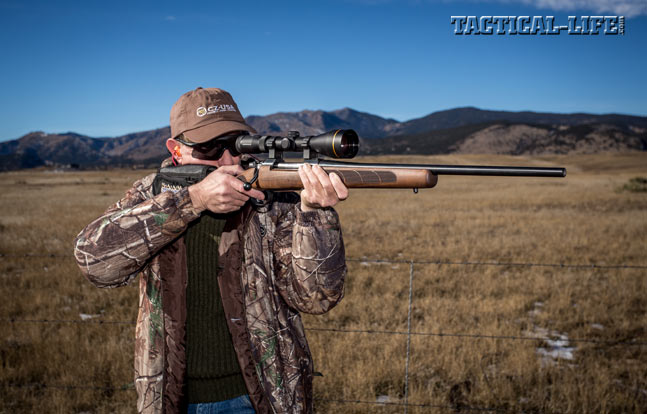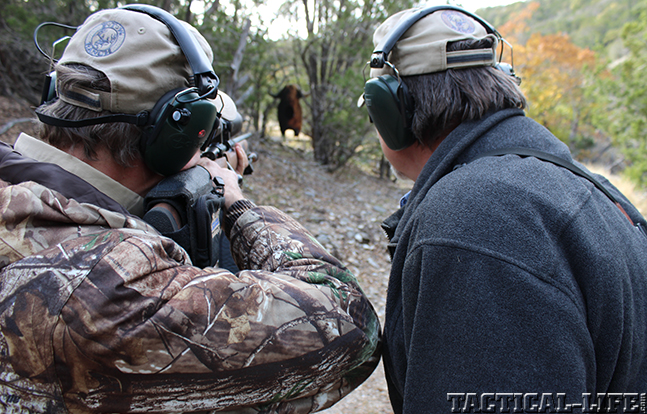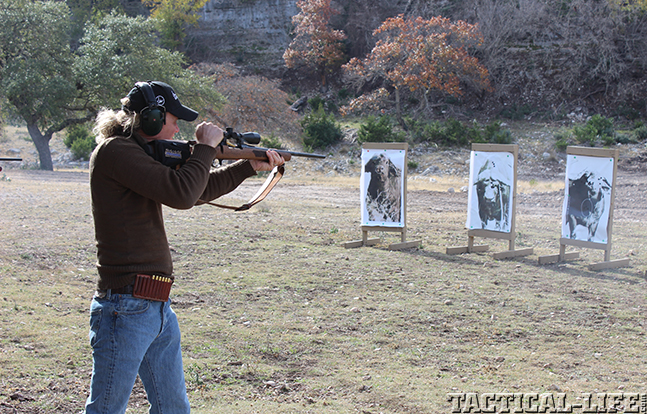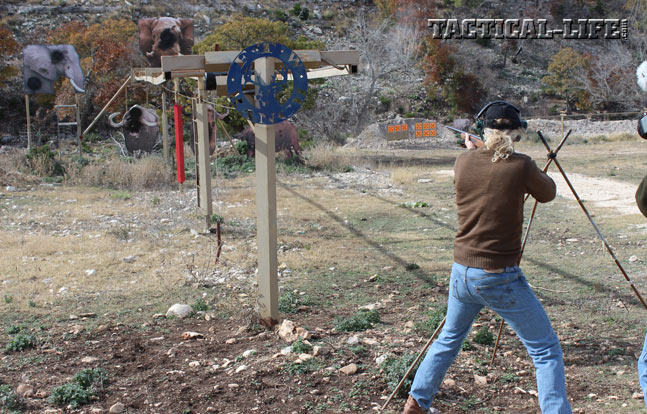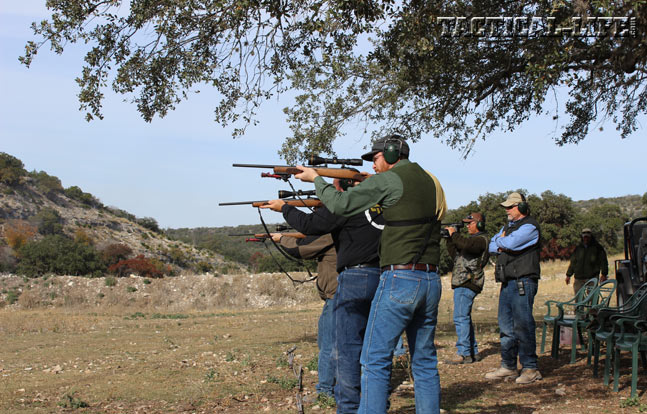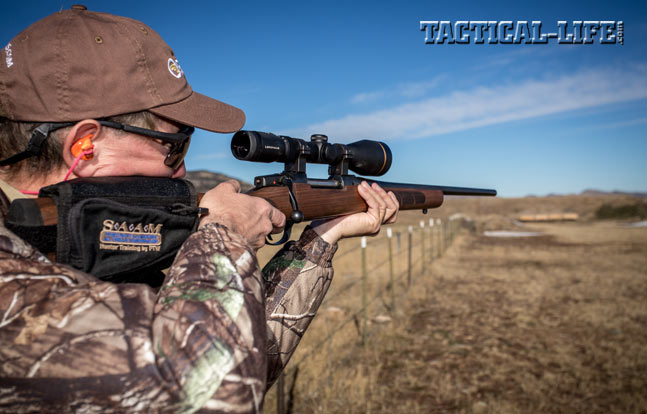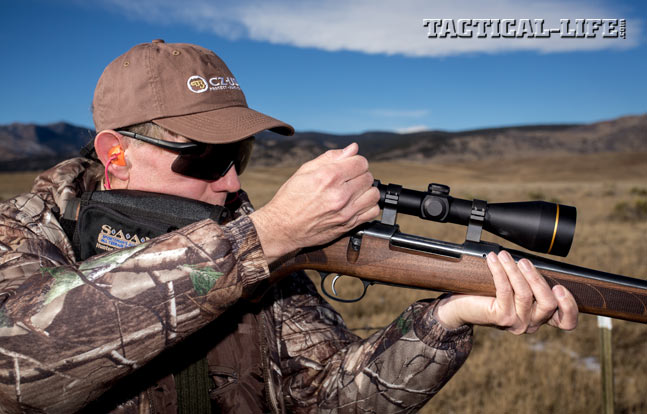In the closing days of 2013, a small group of gun writers and shooting media presenters took part in a shortened version of the standard four-day Sportsman’s All-Weather All-Terrain Marksmanship (SAAM) class offered for hunter training by FTW Ranch, a prime hunting ranch located 2.5 hours from San Antonio in the beautiful rolling hills of southern Texas. The two-day “Advanced Sales Enhancement Training” class was designed specifically for us to get an overview of the complete course while we evaluated the latest bolt-action rifle from Czech gun-maker CZ, the 557 Sporter.
Each writer was issued a CZ 557 rifle chambered for the .30-06 cartridge. We began the first day in the well-equipped classroom at the FTW lodge, where we covered the basics of bullet drop and drift, zeroing and adjusting the hunting scope, range estimation and sighting in, among other topics. One sign of a good class is the amount of preparation that takes place before the class begins. Generally speaking, people learn better and shoot better when they are comfortable. Since a lot of our time on the range would be shooting from the prone position, we were issued shoulder pads. Our rifles were fitted with bipods and cheekpads, which were items that I for one was grateful for by the end of the second day. In the two days that we writers were on the range, we benefitted from some excellent training by our FTW instructors, who have shooting backgrounds ranging from being U.S. military veterans to African professional hunters (PHs).
Advertisement — Continue Reading Below
Fields Of Learning
Training to hunt big game with a professional guide or hunter is different from most other types of firearms training because the client has input from the PH about selecting which animal to shoot and takes their cue from the professional when it’s time to make the shot. We saw this in two ways at FTW. On the static ranges the objective was to learn marksmanship at extended distances. Each of our instructors worked as a spotter for two to three students. As we learned to adjust the elevation of our scopes for different distances, our instructors also helped us to understand how crosswinds will move a bullet off the target and how to compensate by shifting the point of aim to the left or right. The ability to dope the wind is a learned skill, and I was certainly glad for some professional guidance.
Many of the ranges at FTW are built around small canyons, uneven ground and sloping terrain. It’s possible to watch a bullet contrail through a high-magnification scope as it veers to one side or the other and then dip before it reaches the target—all caused by crosswinds that move in one direction near the shooter and a different direction nearer to the target. This means that in a two-man team of shooter and spotter, it’s the guy behind the spotting scope who literally calls the shots. He may wait for a short lull in a crosswind and then, when the conditions are optimal, will tell the shooter to “send it.” The shooter should be ready and able to press the trigger within about a second and a half of being told. This is the window of opportunity before wind conditions change again or, in a real hunting scenario, the animal moves and the opportunity for a clean shot is lost.
Advertisement — Continue Reading Below
Sporter Specs
The latest offering from CZ is the 557 line of bolt-action rifles. There are three models. The first is CZ 557 Sporter Manners, which has a composite stock based on the MCS Elite Hunter with a carbon-fiber shell for increased rigidity, and it includes aluminum bedding pillars. The second model is the CZ 557 Carbine, which has a more traditional walnut stock and backup iron sights. The front sight has a fiber-optic insert for fast target acquisitions at shorter ranges. This is the more conventional setup for professional hunters who have to finish off wounded game their clients didn’t shoot properly in the first place.
The third model of CZ 557 rifle is the Sporter, which, again, was issued to each writer at the FTW Ranch. Each rifle already had optics mounted: a Leupold VX-R 4-12x50mm scope with a red dot at the center of the duplex reticle. The CZ 557 Sporter features a walnut stock with a subdued oil finish and a premium, cold-hammer-forged, factory-lapped barrel.
Advertisement — Continue Reading Below
The bolt action is a push-feed design with a short extractor. This design was chosen so that the action will allow single rounds to be loaded easily. In addition, the two-position safety allows the bolt to be cycled while the safety is in the “safe” position. I found this to be a great advantage when we conducted our sight-in drills from the prone position, and the ability to top off the magazine is a nice feature when hunting deer and other game. The rifle’s action is also fully machined from bar stock with no castings.
The CZ 557 Sporter has an excellent trigger that is fully adjustable by the shooter for their preferred weight, creep and overtravel. However, I felt no need to adjust the trigger on my rifle, which I found right out of the box to be light and smooth with no overtravel. It proved to be great for the long-distance precision shooting we did on the second day of class.
Fully integrated scope bases eliminate the need for screws—which can fail on other scope mounts—and because there is no need to drill and tap holes for screws, there is no potential for misalignment issues. A hinged-floorplate-type integral magazine holds four rounds plus one in the chamber. All three CZ 557 models feature a soft rubber recoil pad.
Advertisement — Continue Reading Below
For 2014, the CZ 557 Sporter is available in several calibers and also in short and long action sizes. The short-action chamberings include the .243 Winchester and .308 Winchester. The long-action chamberings are the .30-06 Springfield, .270 Winchester and 6.5x55mm. In short, it’s an impressive rifle, and I have only one suggestion for improvement. While traditionalists will appreciate the look of walnut and blued steel, I’d like to see at least one of these three 21st century models offered in a finish other than standard 19th century bluing. Something like Teflon-S or NP3 would be more durable for a hunting rifle.
1,000-Yard Hits
We used Hornady’s 150-grain, .30-06 Springfield InterLock ammunition, which is part of the company’s American Whitetail line, with a tapered copper jacket and a lead alloy core that is exposed at the tip. While this is an excellent load for short- to medium-range deer hunting, it’s not exactly the cartridge of choice for long-range precision shooting. However, our FTW instructors were determined to give us the complete experience of a precision shooting course at FTW, and so we loaded up and began the process of turning a simple hunting cartridge into a precision projectile that would ring a steel plate at 1,000 yards.
Advertisement — Continue Reading Below
Precision shooting requires not only an accurate rifle and cartridge combination, but also a stable shooting position. On Day One, on a 250-yard known-distance range, our first drill was to go prone with bipods attached and sight-in at 100 yards on paper. With our instructors calling the shots and helping us adjust our scopes for windage and elevation, we proceeded to shoot some decent three-round groups. Once we had accomplished this, we reset our windage and elevation dials to zero, which would give us an actual range with that specific ammunition up to 250 yards without having to adjust our scopes or hold-over the crosshairs above the desired point of impact, although we still had to adjust our point of aim from left to right to account for wind gusts. Throughout the two-day class, as much as we adjusted our Leupold scopes from one scenario to the next, they always returned to the base setting without any deviation of zero. Click adjustments were always predictable and reliable. They are excellent scopes.
By the end of the first day we were shooting on a range that dropped 300 feet to the valley floor and then rose gradually away from us. Various steel targets littered the range floor out to 975 yards. By now, all the students were making good hits with their hunting rifles at great distances. Our instructors also took the opportunity to stress that ethical hunters do not make extreme long-range shots on live game and risk leaving the animal wounded. Hunting is about getting close enough to the animal that a quick kill is a near certainty. Making those hits was a real challenge, at least for me, but fortunately our instructors were very good at getting the best out of us.
Buffalo-Breath Range
Advertisement — Continue Reading Below
On day two we shot from a standing position on paper targets of buffalo at a range of around 25 yards. After the first exercise on static paper, we switched to moving targets that ran from right to left at a range of around 30 yards. This is designed to simulate shooting a moving animal. Other moving targets simulated a charging elephant coming straight at the shooter and required one or more solid hits in the vital area. Our instructor also taught us how to use three sticks as a simple tripod to support the rifle in the field for a precision shot. Fortunately, I remembered to dial my scope down to the lowest power setting. This really helped to make quick, accurate shots at short distances.
“Other moving targets simulated a charging elephant coming straight at the shooter and required one or more solid hits in the vital area.”
The Dangerous Game Range is a walk-down trail where the shooter, following the PH, walks from one shooting scenario to the next and the PH directs the shooter where and when to shoot, just like a real hunt. At one stage we encountered a full-size, lifelike target of a buffalo that required a head-on shot into the vitals. At another shooting position, we lay prone and hunted over a pond where crocodiles lay submerged with only their eyes and snouts above water.
Advertisement — Continue Reading Below
We were also shown a slightly different variation of taking our cue to shoot from the instructor. The range was a simulation of hunting in Africa over bait. The student and instructor set up in a camouflaged blind at ground level about 30 to 40 yards away from a “dead” antelope bait hanging in a tree. The instructor remotely triggers the appearance of a leopard silhouette target over the bait. The student waits for the instructor to choose the best time to shoot. Three squeezes on the student’s arm were the signal to take the shot. This way, sound doesn’t spook the cat. But things don’t always go according to plan, which is why we call this training and not hunting. When it was my turn, as soon as the cat silhouette target was electronically swung into view, I shot it. I should have waited for the guide’s signal, but too many years of self-defense classes made me shoot as soon as I had identified the target. It was a lesson learned; not all firearms training is applicable to all circumstances.
“With some help from our instructors behind the spotting scopes, every student in the class made the shot out to 1,000 yards!”
Our final exercise of the class was on a range with steel plates every 50 yards out to 1,000 yards where the wind blew in many different directions at different distances to the target. We went out to distances beyond what could be dialed using the reticles as holdovers. This drill was designed to show us how to use the duplex reticle in our scopes to manually hold-over the target. With some help from our instructors behind the spotting scopes, every student in the class made the shot out to 1,000 yards! That’s pretty good for a hunting rifle with hunting ammunition, and it shows the quality control that CZ, Hornady and Leupold apply to their products.
Advertisement — Continue Reading Below
The new CZ 557 Sporter works very well up close and at extreme ranges.
FOR MORE INFORMATION
CZ-USA
CZ-usa.com; 800-955-4486
FTW Ranch
FTWoutfitters.com; 830-234-4366
Hornady
Hornady.com; 800-338-3220
Leupold
Leupold.com; 800-538-7653
